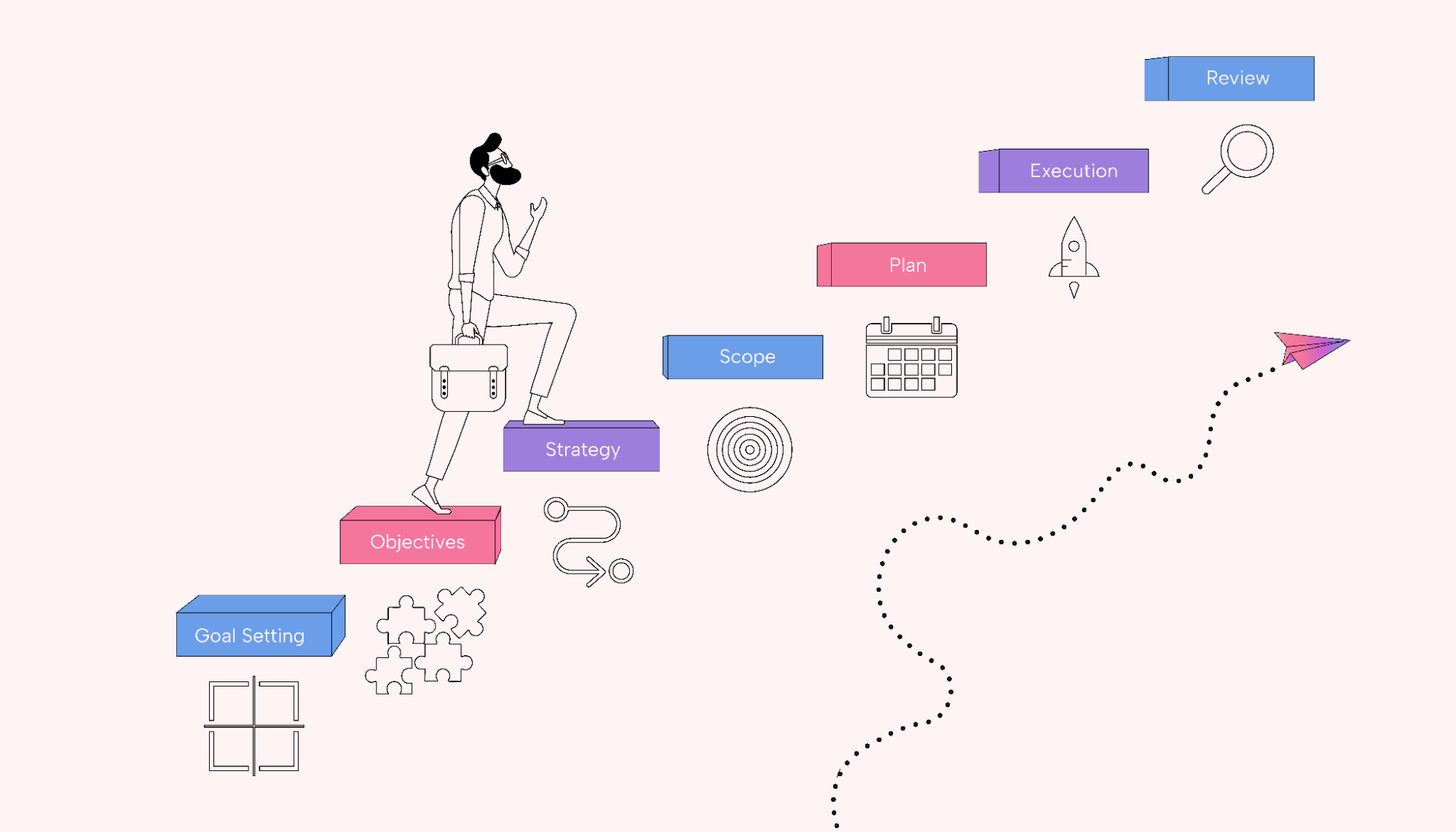Strategic initiatives are the engines that drive business growth.
Without carefully considered initiatives, your goals and objectives remain pipedreams. Your company may continue to experience the same issues. You might need more innovative ideas to scale profits and streamline systems.
This article will discuss ways to develop and enhance strategic initiatives to make meaningful steps toward growth.
What are strategic initiatives?
Strategic initiatives are sets of coordinated activities to achieve specific company goals. Often, they’re designed to give the business a competitive edge, improve efficiency, or scale opportunities.
Maybe a company wants to boost its profits or step into a new market. Perhaps they’re looking to reshape their purpose or tackle quality issues. That’s where strategic initiatives come in.
These initiatives are the backbone of business strategy, bringing a company’s long-term vision to life. Strategic initiatives provide actionable steps when a company wants to accomplish its goals.
But why are they so important?
Strategic initiatives aim for significant results. These multi-step projects don’t just help companies earn a few extra dollars. They make significant changes that help companies scale, evolve, and overcome problems.
Impactful initiatives align a company’s daily tasks and available resources with its larger goals.
This drives businesses forward logically, keeping them relevant in fluctuating markets.
Types of strategic initiatives
There are a wide range of initiatives to help businesses achieve different strategic goals. Are you trying to expand into new markets? Perhaps you want to pivot to offer a new service or remedy a continuous issue.
The type of initiative you put into action will depend on the actual goal you’re trying to achieve.
 |
Corrective: Also known as fix-and-prune initiatives, these measures remedy ineffective and inefficient operations. The goal is to streamline systems to save time and money.
For example, an online retailer may be experiencing poor reviews due to its slow customer service. The company installs a chatbot to speed up response times for all basic queries so customer service agents can focus on complex issues.
Constructive: These initiatives aim to amplify organizational capabilities and improve resources. By enhancing internal resources, performance should improve.
So, a landscape design company may invest in sustainable gardening training. Now, it can offer eco-friendly outdoor spaces.
Expansive: These projects focus on growth opportunities, also referred to as build-and-create initiatives. The aim is to widen the company’s reach to stay competitive and expand their reach.
For instance, an adult fashion brand may introduce childrenswear to gain market share.
Innovative: These initiatives are about promoting creativity to initiate industry breakthroughs. The idea is to keep companies at the forefront of their industry to stay ahead of their competitors.
For example, an electric car company may fund research into next-generation battery technology. That way, their cars stay on the road longer than other electric car brands.
Disruptive: Disruptive initiatives aim to bring radical change. The aim is to boost your company to the dominant position within their sector.
Let’s say an airline introduces a commercial subscription model for frequent flyers. This drastically alters the traditional payment structure. Now, the company is the most cost-effective solution for employees taking business flights.
Defensive: These strategies safeguard organizations from threats to protect assets, data, and reputation.
For example, a financial firm may worry about potential data breaches. So, they introduce advanced cybersecurity measures to protect themselves.
How to develop impactful strategic initiatives: step-by-step guide
Follow this step-by-step guide to create strategic initiatives that bring your vision to life.
 |
Step 1: Goal setting
Every initiative begins with a clear strategic goal. Identify your strategy's purpose and ensure the proposed outcome is measurable.
For instance, a Facebook and Instagram social media agency wants to increase its customer base. It notices a spike in queries about TikTok marketing. They set a goal to increase their client base by offering TikTok strategies for their clients.
Alternatively, a plumbing business wants to increase the total customer spending of its existing client base. After asking customers which services they’d like added, they plan to offer electrical services alongside plumbing.
Step 2: SMART objectives
SMART (specific, measurable, achievable, relevant, and time-bound) objectives are clear targets. These objectives fit under the larger goal to help you craft measurable steps toward your goal.
Say our agency wants to master TikTok marketing strategies. First, they need to analyze the market to understand how TikTok users utilize the platform. Next, they’d set specific objectives around training teams in TikTok marketing techniques, creating a portfolio to showcase to potential clients, and partnering with key influencers.
An example objective may be to train five team members by the end of the quarter or to partner with ten influencers by the end of the year.
Step 3: Strategy
Now that you’ve set your objectives, you need to design strategies that help you achieve them.
Let’s stick with our TikTok theme. The agency would create strategies around staff training, portfolio creation, and influencer partnerships.
For example, they may create a step-by-step plan for approaching influencers based on affiliate packages they’ve seen other brands use.
Step 4: Scope
Before jumping into action, you need to define the scope of your strategies. You need to figure out how much you’re willing to spend, how long it’ll take, and what resources you’ll need.
Our marketing agency may decide that they have $5,000 to spend on training. They’re willing to dedicate three months to training five team members. They’ll need training materials, expert trainers, and new devices for staff to practice their skills.
Step 5: Plan
Next, you’ll need to develop a strategic plan. Detail the action steps, when they should happen, and big milestones to signify progress.
Let’s take the TikTok example. The marketing agency will create a comprehensive roadmap that outlines:
- What training will take place and when
- The tasks needed to build a portfolio
- The actions to bring influencers on board
Milestones may look like this:
- Staff training will be finished by the end of month three.
- Three portfolio campaigns will be completed within six months — one by the end of month two, one by month four, and one by month six.
- The agency will have ten influencers on board by month five and twenty by month eight.
Step 6: Execution
Now is the time to execute the plan. Your team will complete the tasks outlined in the plan, recording progress and tweaking actions where needed.
The agency would train its staff, execute campaigns, build a portfolio, and set up deals with influencers.
Step 7: Review
Once the strategy is in place, you need regular reviews to ensure it performs as expected. Look for insights into where it’s bringing the desired results and where it’s slow to make an impact.
The marketing agency would track client onboarding rate, assess client feedback, and measure campaign success to understand team proficiency.
5 best practices to gracefully execute strategic initiatives
The secret to robust initiatives is good planning, effective teamwork, and regular reviews. That way, everyone knows exactly what to do, what’s working, and where improvements must occur.
Streamline the planning process
Detailed, achievable plans help you to reach your strategic objectives by tying actions to outcomes. You’ll need to understand your goals, clearly identify the initiatives, and set milestones that help you track progress as you go.
Intelligent project planning tools, like Motion, can help to streamline this process. They can reduce manual scheduling and hands-on prioritization. Motion will build everyone’s schedule based on task urgency and team availability. Everything gets done on time and is flexible to change without hours wasted on manual planning.
Install effective communication systems
For your strategic initiatives to run smoothly, everyone needs to know what they’re doing so your team is on the same page.
Clearly articulate your visions and strategic goals to your team. Ensure everyone's clear on the role they play in achieving those milestones. Put accountability mechanisms in place so everyone knows what they’re responsible for.
Promote a culture of transparency by keeping relevant team members up-to-date on requirements and changes in real-time.
Pick a project management tool that facilitates real-time communications in one place. For example, Motion’s personalized, automated alerts ensure everyone’s updated on changes. This keeps everyone accountable and makes sure nobody’s unsure about their next steps.
Prioritize seamlessly and strategically
Prioritizing tasks by their strategic significance maximizes the chances of meeting milestones.
Understand the impact of each task and how it helps you achieve your strategic goals. Prioritize tasks effectively so that the right team member completes these actions in enough time to meet your targets. Review your priorities regularly and update them as requirements shift.
 |
It’s much easier to prioritize your tasks with Motion. It automatically reschedules your teams’ calendars as task urgencies change. Now, everyone meets deadlines without feeling overwhelmed.
Continuously review strategies
Don’t let your strategies stagnate. Reviewing strategies helps you recognize what’s making an impact and what isn’t. That way, you can quickly adjust your actions to have the biggest positive effect.
Good planning springboards effective strategies
Strategic initiatives aren’t optional.
If you want to see actionable change, strategic initiatives help you to create a target, draw a roadmap, and follow it to the bullseye.
You need effortless planning processes to create impactful strategies and keep them current.
Motion helps you organize your team’s schedules by automating scheduling and prioritization. That way, you can plan strategic initiatives quickly, follow up easily, and execute effectively.





